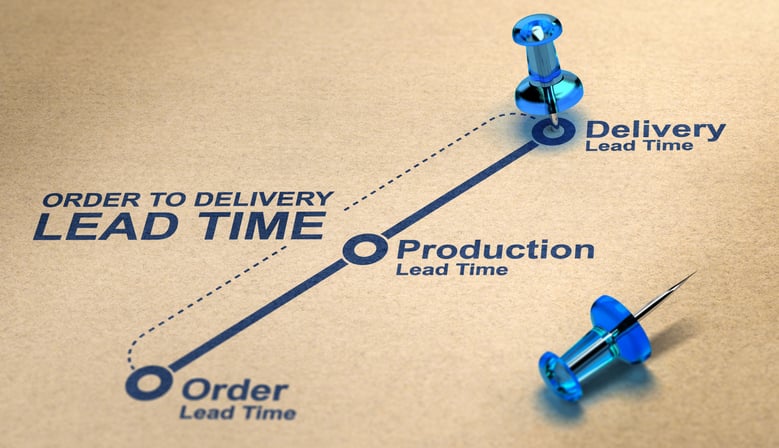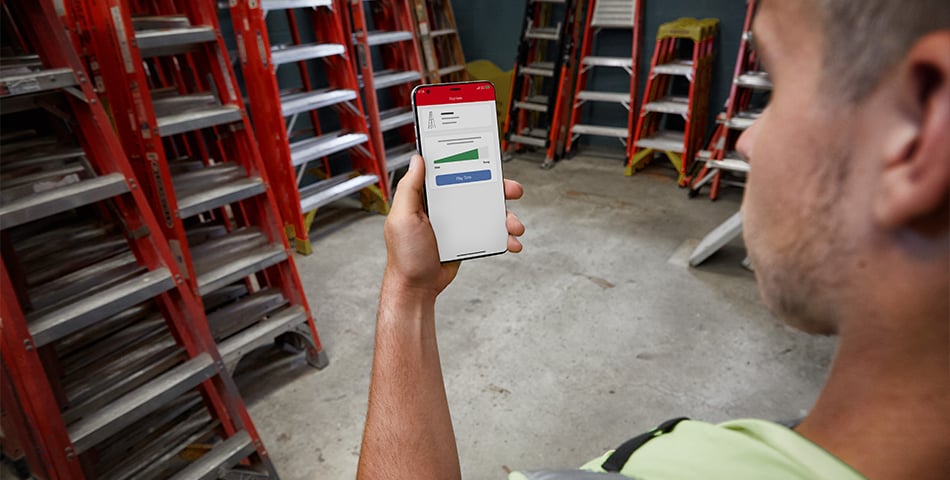
When working with any entity—whether turning to a supplier, simply collaborating with a coworker, or delegating tasks to a subordinate—questions about completion are bound to arise: “When will you get this done by?” “How long will this take you?” “Do you have what you need to prioritize this?” You may even use a more technical term: “What is your average lead time when completing jobs like this?” “Can you give me your lead time for this job?”
Lead time is an important inventory KPI that businesses, small and large, across various industries look to improve. For example, a small computer repair shop may look toward hiring another technician to help with workloads as the shop’s business grows, a retailer may seek seasonal help to handle an influx of customer demand during the holidays, and a builder may turn to construction automation for addressing the persistent talent shortages they face as project backlogs continue to grow.
Outside of pure business viability considerations, scholars also outline the importance of lead time in making ordering decisions, recommending, for instance, that managers use carbon cost change as reference point, and then balance inventory cost and service level to maintain a minimum carbon cost (Li et al).
In this article, we look to provide a more detailed breakdown of what “lead time” is, offer lead time examples across various industries (e.g., supply chain, logistics, manufacturing, etc.), and outline strategies to reduce lead time.
Jump Ahead:
Lead Time Definition: What Does Lead Time Mean in Supply Chain, Inventory, Logistics?
Lead time is defined by Meriam Webster as "the time between the beginning of a process or project and the appearance of its results.”
Scholars define lead time, or order lead time, or “formally procurement lead time” as “the length of time between the time when an order for an item is placed and when it is actually available for satisfying customer demands” (ref Liao).
Additional lead time definitions/meanings may vary depending on industry—e.g.,
- What Is Lead Time in Manufacturing and Supply Chain? In manufacturing, lead time represents the time it takes to build a product (whether for a single client or a bulk order from a vendor, like a retailer) and is measured from the time the order is made to final delivery to the vendor.
- What Is Lead Time in Shipping? In shipping (e.g., like the post office, FedEx, UPS, etc.), lead time might represent the time it takes from the end customer to receive their package—measurable from the time the customer makes the order, the sender (e.g., supplier) prepares the package, the shipper (e.g., USPS, FedEx, UPS, DHL, etc.) sends the order, and the mail courier drops it on the customer’s doorstep. For all intents and purposes, the estimated delivery time a customer sees can be thought of as lead time for their order.
- What Is Lead Time in Project Management? Lead time in project management may differ by industry. For example, in software, it may represent the time it takes to build a piece of software (software feature or entire program), from initial scoping to development, testing, and final deployment. In construction project management, it may refer to the time it takes from initial bid to final delivery of finished a building product (whether that's prefab delivering roof trusses to site or a construction project manager walking a client through a completed building).
What Is Lead Time Vs Cycle Time
Lead time is often used interchangeably with a related term, cycle time, which scholars note is “measured from when work starts until the item is delivered, synonymous with production lead time” — scholars also define lead time as “the time to develop the product (the elapsed time from the start of design until final acceptance from the customer), analogous to order lead time” (ref Turpin, Jr.). The phrasings, “until the item is delivered” as well as “the elapsed time from start to finish until final acceptance from the customer,” are a key distinction of lead time, cycle time, and another term, “takt time,” which we’ll discuss in the next section.
Simply put:
Lead time describes the whole process, from start to finish—the time period in which a product is produced and measurable as soon as a customer makes a purchase and concluding as they receive the product, the amount of time from product order to final delivery.
How does this differ from cycle time? iSixSigma distinguishes the two terms, lead time and cycle time, noting that “A good way to remember how they are related is that Cycle Time can be thought of as a component of Lead Time [where] Lead Time refers to the amount of time between when an order is placed and when it is delivered, [and] Cycle Time refers to only the amount of time when actual work is done to complete an order.”
Lead Time and Takt Time
In addition to cycle time, lead time is also often used in relation to another, related term: takt time.
I’ve described takt time in the Lean Construction Blog, explained as:
"Measurable beat time, rate time, or heartbeat. In Lean, Takt time is the rate at which a finished product needs to be completed in order to meet customer demand (field demand). When you produce to a specific takt, this allows you to truly flow product through your shop to the field with minimal inventory along the way.”
Source: Lean Construction Blog
FreshBooks defines these terms in relation of each other:
Takt time, they define broadly, as “how efficiently work needs to get completed to deliver requests,” while cycle time refers to “how much time your employees require to produce an item up until the point it’s ready to get shipped,” and lead time as (from start to finish) “the amount of time from product order until the time of delivery.”
Takt time and cycle time, they add, “can be used together to help deliver orders on time.” They recommend closing the gap between these two times—takt time, meaning the efficiency of work completion relative to order demand, and cycle time, the actual measurable period needed to produce an item for delivery—in order to “see any areas where adjustments might be needed.”
Lead time, finally, can “automatically become optimized” when cycle time is understood. “Cycle Time is what you can do and Takt Time is what you need to do,” whereas lead time explains the entire process, from start to finish, what you might tell a customer they can expect in terms of how long they’ll be waiting from initial order to the final order delivered on their doorstep.
What Is a Good Lead Time?
Providing a hard number to answer the question “what is a good lean time” is challenging because lead time may differ depending on the industry as well as more contextual factors such as the size of the business, the number of customers, demand, and so forth.
For example, in the electronics industry, lead times for components like Intel chips have recently fallen around 22-28 weeks (actually down from 45-52 weeks), according to a report by Sourcengine. In the construction sector, meanwhile, lead time for critical materials (e.g., steel joists, electrical switchgears, roofing membranes, precast concrete, etc.) has ranged from a few weeks to several months (while factors like the COVID-19 pandemic have multiplied these times, although more recent reports have indicated industry lead times to have recently dropped by 25%).

Lead time is on the rise in manufacturing. For example, Bloomberg reported figures from the Institute for Supply Management showing it “taking an average 100 days to receive production materials, the longest in records dating back to 1987,” while for capital expenditures, “the average commitment time rose to a whopping 173 days, matching the highest on record.”
Lead Time Calculation: What Is Lead Time Formula? How to Calculate Lead Time
iSixSigma also provides some common ways to calculate lead time:
Lead time, they explain, is commonly calculated by subtracting the order delivery date from the order request date:
Lead Time (LT) = order delivery date – order request date
Calculating lead time as part of inventory management, they explain, includes reordering delay and the supply delay:
Lead Time (LT) = supply delay (SD) + reordering delay (RD)
In manufacturing, they add, lead time refers to the length of time in processing, preparing, manufacturing, and delivering an order—with lead time as a metric calculated by adding the preprocessing, processing, and post-processing time lengths until the delivery of an order:
Lead Time (LT) = preprocessing + processing + postprocessing
Lead Time Examples: How to Control Lead Time & Improve Order Efficiency
Looking for some lead-time examples and how to improve order efficiency in your company supply chain?
Many methods exist to control lead time:
Increased Collaboration
We’ve previously talked with SMEs in supply chain who have described “partnership” as a key component of improving organization and streamlining workflows. If you’re able to keep an open dialogue with subcontractors, for example, you’ll be able to better judge and more accurately predict timelines to customers based on available resources, backlog statuses, and demand.

Studies have shown that collaborative relationships among trading partners to have a positive impact on lead time reduction (ref Singh). “Australian manufacturing plants showed that there were strong albeit indirect links between collaborative practices that firms develop with key customers and suppliers, and lead time performance,” one scholar writes.
Similarly, scholars describe pre-cooperation and eight cooperative orders over a period of 14 months resulting in a significant average reduction of 30.8% in the duration of lead times (ref Ghaderi et al.).
Remove Inefficient Processes
In addition to improving collaboration, reducing process inefficiencies can greatly impact lead-time reduction.
This can be anything from adopting newer, more robust processes (like industrialized construction) to eliminating poor data management processes. As an example, scholars found that using an integrated inventory model can provide a lower total cost and shorter lead time compared with more traditional methods (ref Pan and Yang). The use of an enterprise resource planning (ERP) system and proper IT management and integrations, as we’ve defined and discussed before, can also prove helpful in reducing lead time. Scholars writing for MIS Quarterly provide evidence to this point, finding that “system implementation gave rise to an ongoing trend of performance improvement” (ref Cotteleer and Bendoly).

Just-in-time inventory, a method that seeks to deliver only what’s ordered, as it’s ordered, may also provide a way to cut down costs.
Procure the Right Safety Stock & Rethink Suppliers
Inventory procurement plays a critical role in reducing lead time. Here, we describe two methods: safety stock and supplier relationship management.
Safety stock
Safety stock is the extra quantity of supplies or resources deliberately set aside as a precaution against events that can’t otherwise be planned for (and a stockout preventor).
Safety stock and lead time have been studied with scholars finding that “decreasing the lead time uncertainty, in fact, increases the required safety stock” (ref Chopra et al.), hence procuring ample safety stock in uncertain times is critical to maintain consistent lead times.

What’s more, scholars signal “backup supply” to be of utmost importance in supply chain resilience performance relative to lead time (ref Chang).
Having a hard time calculating necessary safety stocks? We’ve answered the question: What is a good safety stock?
Suppliers
It's important to maintain open communication and collaboration with your suppliers (as we discussed earlier). As was the case for Apple, fewer suppliers and strengthening with these suppliers played a major role in saving the company from bankruptcy and ushering in a new era of lean management.
A good relationship with a preferred supplier may prove helpful at the negotiation table, but also, you might consider alternative ways to save on building materials to help reduce lead time and cut down on costs—e.g., purchasing prefabricated materials, buying in bulk/wholesale, selecting cheaper, easier-to-install materials, limiting change orders, etc.
Ways Tool Managers Can Improve Inventory Lead Times
Tool managers play an important role in reducing equipment related construction downtime.

Some methods tool managers can use to ensure there’s proper flow of inventory to their network of jobs:
- Cloud-based inventory system and integrations – a cloud-based inventory app that’s accessible wherever you’re working (e.g., in the tool crib, on the job, in a service van, etc.) is critical to maintaining real-time visibility to assets. Integrating across your team’s tech stack (as we discussed earlier, like project management, design, ERP, etc.) ensures everyone has real-time visibility into inventory-related information. Related Read: 5 Advantages of Digitizing Your Tool Inventory
- Inventory tracking and tagging – on top of a cloud-based system, equipment tagging methods like barcodes, RFID, Bluetooth tagging, GPS tracking, etc. feed an inventory dashboard with the real-time location updates.
- Using digital tools to troubleshoot item locating – features like location history and find item can respectively help tool managers understand item usage to make better, data-informed decisions about continued use, and troubleshoot in-vicinity finding to cut down how long it takes to prepare an order and see its safe return. Pairing these features with complimentary organization products, both physically like PACKOUT modular storage and digitally via tool kitting, can help achieve greater onsite productivity enabled by a digital twin.
Final Word
Lead time plays an important role in improving the customer experience, particularly in the construction sector that is continually plagued by industry impediments (e.g., dearth of talent, rising costs, etc.). Focusing on improving controllable factors related to lead time can help improve order efficiency, enhance production through increased collaboration and project transparency, and significantly improve the customer experience over time, no matter how dire circumstances at first appear.
References
- Chang, W-S. and Lin, Y-T. (2019, 12). The effect of lead-time on supply chain resilience performance. Asia Pacific Management Review 24(4), 298-309, https://doi.org/10.1016/j.apmrv.2018.10.004
- Chao-Hsien Pan, J. and Yang, J-S. (2010, 11). A study of an integrated inventory with controllable lead time. International Journal of Production Research 40(5), 1263-1273, https://doi.org/10.1080/00207540110105680
- Chopra, S., Reinhardt, G., and Dada, M. (2004). The effect of lead time uncertainty on safety stocks. Decision Sciences 35(1), https://doi.org/10.1111/j.1540-5414.2004.02332.x
- Cotteleer, M-J. and Bendoly, E. (2006, 09). Order lead-time improvement following enterprise information technology implementation: An empirical study. Management Information Systems Quarterly 30(3), 643-660, https://www.jstor.org/stable/25148743
- Ghaderi, H., Dullaert, W., and van Amstel, W-P. (2016, 01). Reducing lead-times and lead-time variance in cooperative distribution networks. International Journal of Shipping and Transport Logistics 8(1), 51-65, http://dx.doi.org/10.1504/IJSTL.2016.073316
- Liao, C-J. and Shyu, C-H. (1991, 02). An analytical determination of lead time with normal demand. International Journal of Operations & Production Management 11(9), 72-78, https://doi.org/10.1108/EUM0000000001287
- Li, Z., Fei, W., Zhou, E., Gajpal, Y., and Chen, X. (2019, 09). The Impact of Lead Time Uncertainty on Supply Chain Performance Considering Carbon Cost. Sustainability 11(22), 6457, https://doi.org/10.3390/su11226457
- Singh, P. (2009). Improving Lead Times through Collaboration with Supply Chain Partners: Evidence from Australian Manufacturing Firms. In: Reiner, G. (eds) Rapid Modelling for Increasing Competitiveness. Springer, London. https://doi.org/10.1007/978-1-84882-748-6_23
- Turpin Jr., L. (2018, 11). A note on understanding cycle time. International Journal of Production Economics 205, 113-117, https://doi.org/10.1016/j.ijpe.2018.09.004